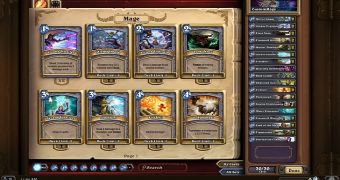A recent interview offered some additional information regarding the making of the free-to-play digital trading card game Hearthstone, a product which surprised many players when it was first unveiled at the Penny Arcade Expo, around a year ago.
Eric Dodds is a well-known Blizzard developer, having previously worked on both World of Warcraft as well as Diablo 3 before being appointed as lead designer on the Hearthstone team. During an interview with Gamasutra, he opened up about some of the aspects which influenced the development of Hearthstone.
Hearthstone and its small development team are a significant departure from Blizzard's usual manner of handling game development, the team starting out as a handful of people and growing to around 20 members in the present, which is very small compared to the around 100 people working on Diablo 3 or the over 100-large development team working on World of Warcraft.
He explains that the genesis of Hearthstone lies in the "folks at Blizzard" looking at the way the company operated and seeing projects that the devs were very excited about pursuing, but unable to do so because everyone had very large teams working on big projects with huge scope and an extended development timeline.
The decision to make a small, rather experimental team was made, in order to be able to tackle the small projects and see what could become of them, and who could hopefully develop prototypes much faster.
Hearthstone was spawned from the team's love for collectible card games, as each and every one of them was an avid player, having played them at Blizzard from the very beginning and being very passionate about them. They were wondering why there aren't more people playing those amazing games, and figured out a great way to bring CCGs to a larger audience in the form of Hearthstone.
The decision to make Hearthstone a free-to-play game was not one the team started with. As Dodds explains, when they make a game, they focus on what it's about and not on the financial model, which then evolves naturally.
In the case of Hearthstone, they had set out to create a collectible card game, and they wanted to make it accessible to everyone and to show everyone how great card games were; so, it made sense to make it a free-to-play game.
Although nobody knows where exactly the free-to-play market is heading, the model was a "fantastic fit" for Hearthstone, but it's not necessarily an indication on Blizzard’s future plans; it's just indicative of the direction that was best for Hearthstone.

 14 DAY TRIAL //
14 DAY TRIAL //